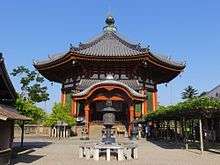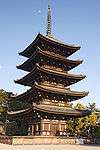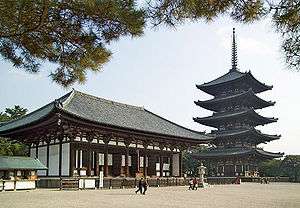Kōfuku-ji
| Kōfuku-ji | |
|---|---|
|
Five-story pagoda and Tōkondō at Kōfuku-ji | |
| Basic information | |
| Location | 48 Noboriōji-chō, Nara, Nara Prefecture |
| Affiliation | Hossō |
| Deity | Shaka Nyorai (Śākyamuni) |
| Country | Japan |
| Website | http://www.kohfukuji.com/ |
| Architectural description | |
| Founder | Emperor Tenji |
| Completed | 669 |
Kōfuku-ji (興福寺 Kōfuku-ji) is a Buddhist temple that was once one of the powerful Seven Great Temples, in the city of Nara, Japan. The temple is the national headquarters of the Hossō school and is one of the eight Historic Monuments of Ancient Nara inscribed on the UNESCO World Heritage List.
History
Kōfuku-ji has its origin as a temple that was established in 669 by Kagami-no-Ōkimi (鏡大君), the wife of Fujiwara no Kamatari, wishing for her husband’s recovery from illness. Its original site was in Yamashina, Yamashiro Province (present-day Kyoto). In 672, the temple was moved to Fujiwara-kyō, the first planned Japanese capital to copy the orthogonal grid pattern of Chang'an. In 710 the temple was dismantled for the second time and moved to its present location, on the east side of the newly constructed capital, Heijō-kyō, today's Nara.
Kōfuku-ji was the Fujiwara's tutelary temple, and enjoyed as much prosperty for as long as the family did. The temple was not only an important center for the Buddhist religion, but also retained influence over the imperial government, and even by "aggressive means" in some cases.[1] When many of the Nanto Shichi Daiji such as Tōdai-ji -declined after the move of capital to Heian-kyō (Kyoto), Kōfuku-ji kept its significance because of its connection to the Fujiwara.
The temple was damaged and destroyed by civil wars and fires many times,[2] and was rebuilt as many times as well, although finally some of the important buildings, such as two of the three golden halls, the nandaimon, chūmon and the corridor were never reconstructed and are missing today.
Architectures and treasures


The following are some of the temple's buildings and treasures of note.
Architecture
- East Golden Hall (東金堂 Tō-kondō), 1425, one of the former three golden halls (National Treasure);[3] the Central Golden Hall (中金堂 Chū-kondō) is currently being reconstructed.[4]
- Five-storied pagoda (五重塔 Gojū-no-tō), 1426 (National Treasure)[5]
- Three-storied pagoda (三重塔 Sanjū-no-tō), 1185-1274 (National Treasure)[6]
- North Octagonal Hall (北円堂 Hoku'endō), 1210 (National Treasure)[7]
- South Octagonal Hall (南円堂 Nan'endō), 1741, Site No.9 of Saigoku 33 Pilgrimage (Important Cultural Property)[8]
- Bath House (大湯屋 Ōyūya) 1394-1427 (Important Cultural Property)[9]
Treasures
- (Statue) The Devas of the Eight Classes, including dry-lacquer Ashura (National Treasure)
- (Statue) The Ten Great Disciples (National Treasure)
- (Statue) Thousand-armed Kannon (National Treasure)
- (Statue) Amoghapāśa (不空羂索観音 Fukūkensaku Kannon) attributed to Kōkei, is housed in Nan'endō (National Treasure)
Plan
Showing the original layout of the temple, with the later Three-storied pagoda, Nan'en-dō, and Ōyūya superimposed. Of the buildings marked, only these three together with the Five-storied pagoda, Tōkon-dō and Hoku'en-dō remain.[10]
Gallery
 Golden Buddha in Kōfuku-ji inside Tō-kondō
Golden Buddha in Kōfuku-ji inside Tō-kondō Yakushi Nyorai (Important Cultural Property) inside Tō-kondō
Yakushi Nyorai (Important Cultural Property) inside Tō-kondō Hoku'endō, older of the two octagonal halls
Hoku'endō, older of the two octagonal halls Gojū-no-tō five-storied pagoda
Gojū-no-tō five-storied pagoda The Sanjū-no-tō stands behind Nan'endō
The Sanjū-no-tō stands behind Nan'endō- Gojū-no-tō five-storied pagoda from below
Notes
- ↑ John Bowring, pp.218-219
- ↑ Turnbull, Stephen (1998). The Samurai Sourcebook. Cassell & Co. p. 200. ISBN 1854095234.
- ↑ "Database of National Cultural Properties". Agency for Cultural Affairs. Retrieved 14 May 2011.
- ↑ "Central Golden Hall". Kōfuku-ji. Retrieved 14 May 2011.
- ↑ "Database of National Cultural Properties". Agency for Cultural Affairs. Retrieved 14 May 2011.
- ↑ "Database of National Cultural Properties". Agency for Cultural Affairs. Retrieved 14 May 2011.
- ↑ "Database of National Cultural Properties". Agency for Cultural Affairs. Retrieved 14 May 2011.
- ↑ "Database of National Cultural Properties". Agency for Cultural Affairs. Retrieved 14 May 2011.
- ↑ "Database of National Cultural Properties". Agency for Cultural Affairs. Retrieved 14 May 2011.
- ↑ Suzuki, Kakichi (1980). Early Buddhist Architecture in Japan. Kodansha. p. 86. ISBN 0-87011-386-0.
See also
- Nanto Shichi Daiji, Seven Great Temples of Nanto.
- List of National Treasures of Japan (temples)
- List of National Treasures of Japan (archaeological materials)
- List of National Treasures of Japan (sculptures)
- List of National Treasures of Japan (crafts-others)
- For an explanation of terms concerning Japanese Buddhism, Japanese Buddhist art, and Japanese Buddhist temple architecture, see the Glossary of Japanese Buddhism.
- Siege of Nara
References
- John Bowring, Richard (2005). The religious traditions of Japan. Cambridge University Press. pp. 77–78. ISBN 0-521-85119-X.
- Noma, Seiroku; John M. Rosenfield; Bin Takahashi (2003). The Arts of Japan: Ancient and medieval. Kodansha International. pp. 84–85. ISBN 4-7700-2977-2.
External links
| Wikimedia Commons has media related to Kofukuji. |
- Kōfuku-ji web site
- Kōfuku-ji web site(Japanese)
- Nara Prefecture page on Kōfuku-ji
- UNESCO
- Exhibition of artifacts from Kofukuji reviewed in The Japan Times
Coordinates: 34°40′59.7″N 135°49′52.2″E / 34.683250°N 135.831167°E

